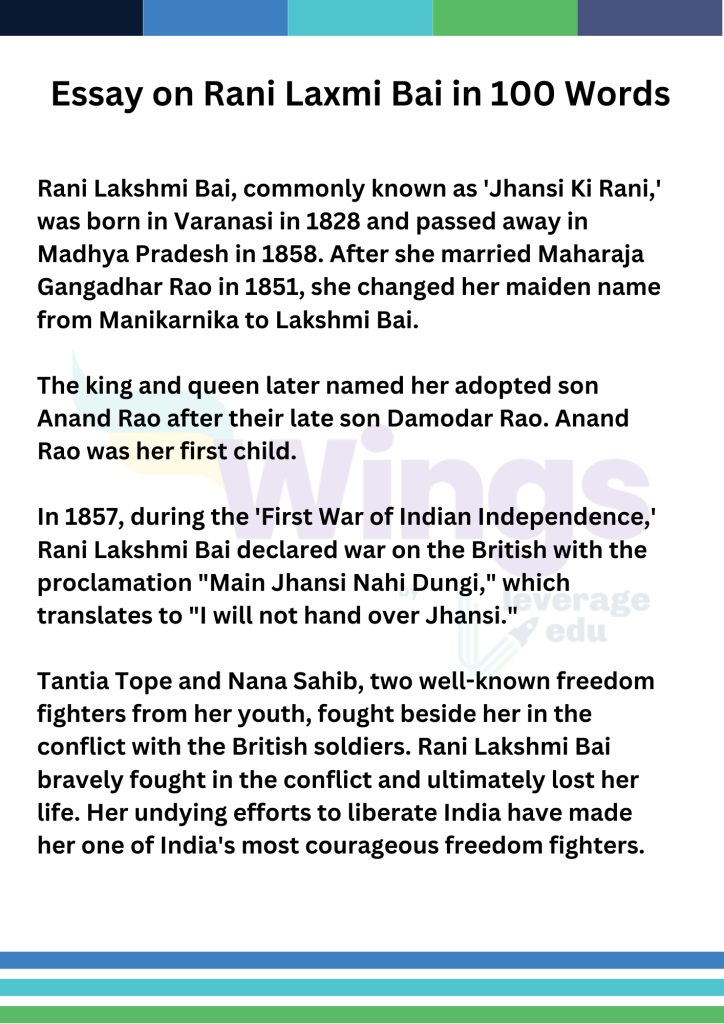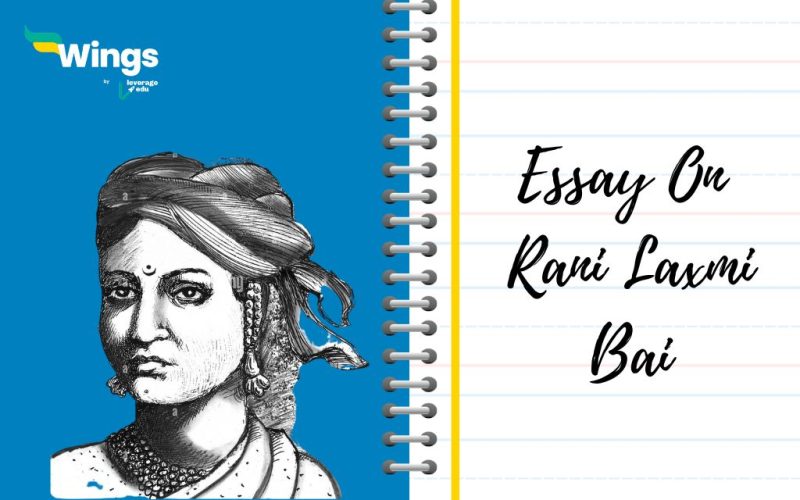From 1843 to 1853, Rani Laxmibai also known as Rani of Jhansi was the Maharani consort of Jhansi in the Maratha Empire as she was married to Maharaja Gangadhar Rao Newalkar. Rani Laxmibai was a prominent figure in the Revolt of 1857. Due to her contribution, she emerged as a resistance symbol to British rule in India.
Tracing her early roots, Rani Laxmibai was born in Benaras into a Marathi Karhade Brahmin family. In 1842 she married Maharaja of Jhansi – Gangadhar Rao. When Raja Gangadhar Rao died, Rani Lakshmi Bai was supposedly going to be the queen of Jhansi but the Britishers refused to recognise this and under the Doctrine of Lapse they annexed the Kingdom of Jhansi. In 1858, while fighting against the oppression of the Britishers, Rani Lakshmi Bai died at the mere age of 29. While this may come as a blow to the Indian freedom movement her legacy of bravery will live till eternity.
Table of Contents
Also Read: English Essay Topics
10 Points to Add in Essay on Rani Lakshmi Bai
- She was a freedom fighter.
- She was known as “Jhansi Ki Rani”.
- She was born in Varanasi.
- She is also known as “Manikarnika”.
- She fought against the British for the freedom of India.
- She was a courageous woman and fought the battle fiercely.
- She is a well-known female fighter in India.
- She died in battle against the British but is immortal as a warrior.
- India’s first battles for freedom were initiated by her.
- She is remembered in history for her valour, courage, and bravery.
Essay on Rani Lakshmi Bai in 100 Words

‘Bundele Har Bolo Ke Muh Humne Suni Kahani this,
khoob ladi mardani woh toh jhansi wali rani thi.’ – Subhadra Kumari Chauhan
Essay on Rani Lakshmi Bai in 250 Words
Born on November 19, 1828, in Varanasi, Rani Laxmibai was the most celebrated freedom fighter of India against British Colonial rule. Till today people talk about her with high regard by mentioning stories of her valour. She was the daughter of Moropant Tambe and Bhagirathi Sapre. Rani Lakshmi Bai’s mother – Bhagirathi Sapri passed her love for learning to her daughter. Apart from getting a good education, Rani Lakshmi Bai was also given knowledge of skills like horseback riding, sword fighting, other martial arts, dancing and singing.
At the age of 14, Rani Lakshmi Bai got married to Raja Rajeshwar Rao, who was the state ruler of Jhansi. When her husband Raja Gangadhar Rao died, she became the queen of Jhansi. Under the Doctrine of Lapse, the British Government refused to recognise Rani Lakshmi Bai as the rightful heir to the throne. This led to the British Government taking over the Kingdom of Jhansi.
She emerged as a prominent figure in the Indian Rebellion of 1857 against the Britishers. Apart from her military achievements, she was also known for her intelligence and strategic thinking. Due to these impressive traits, she was able to garner the support of regional leaders and common people. Her resistance against the Britishers ended in 1858 when she got killed on the battlefield at the age of 29. Although this came as a jolt to the Indian freedom movement, the stories of her bravery and resilience live forever.
Also Read: Non-Cooperation Movement – Features, Causes and Results
Essay on Rani Lakshmi Bai in 500 Words
The bravery, tenacity, and leadership of Rani Lakshmi Bai are still honoured today as a source of motivation for future generations. Her efforts to liberate Bharat (India) are honoured and remembered by the entire country.
Rani Lakshmi Bai was born into a Maratha noble family in Varanasi, India. Her father, Moropant Tambe, served as a courtier at the Maratha Peshwa Baji Rao II’s court. She inherited a passion for learning from her mother- Bhagirathi Sapre. In addition to receiving a strong education, Rani Lakshmi Bai received training in horseback riding, sword fighting, and other martial skills. She was also an accomplished singer and dancer.
Rani Lakshmi Bai married Raja Rajeshwar Rao of Jhansi in 1842 when she was just 14 years old. The couple’s kid, Damodar Rao, passed away in infancy. Rani Lakshmi Bai became the new ruler of Jhansi after Raja Rajeshwar Rao passed away in 1853. Under the Doctrine of Lapse, the British administration refused to accept her as the legitimate heir to the throne and instead conquered the kingdom of Jhansi.
The Indian Rebellion of 1857 was Rani Lakshmi Bai’s most significant contribution to the Indian freedom cause. The East India Company’s army’s men started the rebellion as a mutiny, but it quickly grew into a national insurrection against British control. One of the first to support the insurrection was Rani Lakshmi Bai’s kingdom of Jhansi.
Rani Lakshmi Bai was well-known for her wit and keen judgement. She managed to keep up diplomatic ties with other regional leaders and win the support of the general public. In order to mount surprise attacks on the British army, Rani Lakshmi Bai made use of her local expertise and the community’s support.
In India, Rani Lakshmi Bai paved the way for women’s rights and empowerment. Rani Lakshmi Bai defied social norms at a period when women were supposed to be submissive and limited to domestic work. By assuming a leadership position in the Indian liberation struggle she demonstrated that women could accomplish whatever that men could and that they had the right to take part in the political and social life of their nation.
When Rani Lakshmi Bai was murdered in combat at the age of 29 in 1858, her fight against the British came to an end. Her passing dealt the Indian freedom struggle a serious blow, yet her legacy still lives on.
The horseback ride Rani Lakshmi Bai made at the Siege of Jhansi is among her most well-known and inspirational historical moments. She commanded her army while appearing to be a man, and the soldiers were motivated by her courage and vision. The spirit of resistance against British authority was represented by this deed of bravery and leadership. There is a famous quotation attributed to Rani Lakshmi Bai that reads, “I will not be a helpless witness to the destruction of my people and my country.”
Also Read: Civil Disobedience Movement
Also Read: How to Write an Essay in English
Related Articles
| Essay on Gaganyaan | Essay on Chandrayaan – 3 |
| Essay on Respect | Essay on Shivaji Maharaj |
| Essay on Jawaharlal Nehru | Essay on National Unity Day |
| Essay on Azadi Ka Amrit Mahotsav | Essay on Isaac Newton |
FAQs
A. Mangal Pandey is regarded as the 1st freedom fighter in India. He was the forerunner of India’s first battle against the Britishers for independence.
A. Rani Lakshmibai, also known as Jhansi ki Rani, is India’s first female freedom fighter. She single-handedly with her courage fought against the Britishers.
A. Suniti Chaudhury, who was born on 22 May 1917, is regarded as the youngest female freedom fighter. At the age of 16 yrs old, she assassinated a British magistrate.
This was everything about the essay on Rani Lakshmi Bai! For more information on such informative articles, visit our essay writing page and follow Leverage Edu.
 One app for all your study abroad needs
One app for all your study abroad needs













